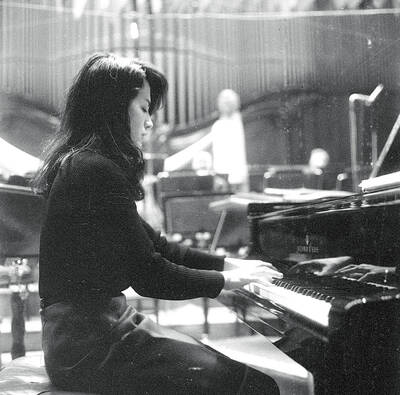The artist Li Mei-shu (1902-1983) supervised the restoration of the Tsu-shih Temple in Sansia in Taipei County. Not only has it been called a hall of eastern art, it is also a temple of birds that any ornithologist visiting Taiwan must visit. In a survey by the Taiwan International Birding Association five years ago, the carvings inside the temple included more than 1,000 birds of 106 different kinds. Of these, seven kinds are unique to Taiwan. Thanks to the Internet and the spread of photographs, the Tsu-shih Temple is now the world’s best known “Temple of birds.”
Simon Liao, president of the Taiwan International Birding Association, said most visitors to the temple focus on the carvings. When Liao and a Canadian friend visited five years ago, they discovered that most carvings in the temple were stone carvings of birds, creating a breathtaking impression of a flock of thousands of birds.
Liao and some of his foreign friends spent five months taking pictures of the more than 1,000 stone bird carvings in the temple, archiving them and then checking the species one by the one. In the end they had confirmed 106 different kinds of bird, including Formosan Blue Magpie, Taiwan Whistling Thrush, Taiwan Firecrest, Taiwan Bush-warbler, White-eared Sibia, and Formosan Laughing Thrush, which all are unique to Taiwan.
Liao said expert evaluations showed that the bird species represented in the Tsu-shih temple carvings were very realistic. He believes Li Mei-shu was not only an artist, but also an early bird lover. These works of art represent a record of rare bird species, and are a reflection of environmental conservation.
Liao later found one of Li’s sons, Li Ching-kuang, who heads the Li Mei-shu Memorial Gallery, and told him of this. Unexpectedly, Li Ching-kuang told him that while he was still alive, his father had said that someone some day would find the reason for restoring the Tsu-shih temple. Late last year, the memorial gallery cooperated with the Taiwan International Birding Association on the publication of a pictorial book that gave an introduction to and explanation of the Tsu-shih Temple from an artistic, a literary and an environmental perspective.
Liao revealed that foreign guide books recommend the temple, saying that it is one Taiwanese temple most worthy of a visit, and that the Tourism Bureau has assisted in the publication of a pictorial book showing the different bird species represented in the stone carvings. That book was published in English, Japanese and Chinese versions, and every copy was quickly snapped up by foreign bird lovers. Liao said that if someone were willing to put up the money for a reprint, the association would be happy to provide the copyright.
(LIBERTY TIMES, TRANSLATED BY PERRY SVENSSON)
台北縣三峽祖師廟由藝術大師李梅樹監修,不只有「東方藝術殿堂」之稱,還是世界鳥友來台必定造訪的「鳥廟」。台灣國際觀鳥協會五年前調查,廟內雕刻有多達一百零六種鳥、超過一千隻,包括七種台灣特有鳥種,經網站和圖鑑宣傳,祖師廟已是國際上知名度最高的「鳥廟」。
觀鳥協會理事長廖世卿表示,大部分遊客造訪祖師廟焦點都集中在建築雕工,五年前他和加拿大友人造訪時,發現廟中作品多數都是鳥類石雕,形成千鳥薈萃的景象,大為驚豔。
廖世卿和國際友人花了五個月,將廟內一千多個鳥類石雕全部拍照建檔,再一一鑑定比對鳥種,最後確認有一百零六種,還包含台灣藍鵲、紫嘯鶇、火冠戴菊鳥、褐色叢樹鶯、白耳畫眉、畫眉及金翼白眉等台灣特有種。
廖世卿說,經專家鑑定,祖師廟內的鳥類石雕相當逼近真實型體,他認為,李梅樹不僅是藝術家,應該也是早期的鳥友,這些藝術作品記錄下稀有鳥類,也和生態保育觀念相呼應。
廖世卿後來找到李梅樹二子、李梅樹紀念館長李景光告知此事,沒想到李景光告訴他,父親生前就交代,「總有一天會有人發現他建造祖師廟的原意」。紀念館去年底也和協會合作,出版名為「百鳥朝梅」圖鑑,以藝術、文學和生態角度,重新詮釋三峽祖師廟。
廖世卿透露,還有國外旅遊書籍推薦,三峽祖師廟是全台灣最值得參觀的廟宇,觀光局曾贊助印製祖師廟的鳥類圖鑑,發行中、英、日文等版本,馬上被國際鳥友索取一空,如果有人願意出資重印,協會可以免費提供版權。
(自由時報記者蔡偉祺)

A: While Taylor Swift’s new album conquers the Billboard charts, Billboard Live Taipei is set to open next month. B: Isn’t that a Japanese “live house” of the same name with the magazine? A: Yup, and the live music club’s first Taiwanese branch can accommodate 300 guests. B: Who will be performing at the club’s opening show? A: Japanese singer Mika Nakashima will play four gigs over two nights. Wanna go to the club and watch her perform up-close? A: 天后泰勒絲的新專輯再度征服《告示牌》排行榜,告示牌音樂台北則預計將在下月開幕。 B: 那不是跟《告示牌》同名的日本現場音樂餐廳嗎? A: 對,這家連鎖餐廳的台灣首店約可容納300名觀眾! B: 開幕秀的表演者是誰? A: 是日本歌手中島美嘉,想近距離看她現場演出嗎? (By Eddy Chang,

In his famous tragic play Romeo and Juliet, the English playwright William Shakespeare wrote, “What’s in a name?” As it turns out, there is quite a lot in a name, particularly a surname, which is commonly known as a person’s last name in Western societies. A surname is written after the first name, which is also referred to as a given name or, traditionally, a Christian name. A closer look at the history of surnames reveals some fascinating insights into their origins. It may come as a surprise to some that up until about 1,000 years ago, surnames were

Rehearsal time is over. The world’s best and most ambitious young pianists have descended on Warsaw for the Frederic Chopin International Piano Competition — for some, a gateway to classical music glory. Fans from around the globe snapped up tickets as much as a year ago. The lucky ones attended the opening night concert on Oct. 3 and will follow along as the contest builds to a thrilling climax on Oct. 20. Winning the Chopin International — held every five years in the 19th-century composer’s homeland — can raise the curtain to playing at venues across the globe and signing contracts

Continued from yesterday(延續自昨日) https://www.taipeitimes.com/News/lang While many early surnames in England were strongly influenced by the work people did, like Carpenter or Plumber, jobs were not the only factor. Physical characteristics, personal nicknames, geographical locations and even parents’ first names also played a role. It’s not hard to imagine how the color of a person’s hair could have led to a surname like “Redhead” or “White,” while a darker complexion might have resulted in the last name “Black.” Meanwhile, someone known as a quick runner might have earned the surname “Swift,” while a clever or cunning individual could have been called “Fox”